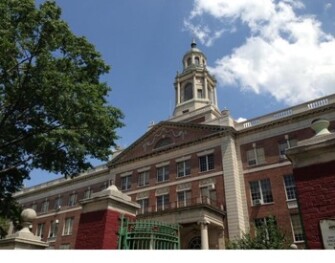This post is by Alexandra Brown, Assistant Principal at the High School for Law and Public Service in New York City.
Today’s post is the practitioner perspective on Monday’s post: 4 Key Strategies for Improving School Culture for Black and Latino Male Students.

My school — the High School for Law and Public Service in New York City — has been fortunate to receive funding and professional development support from the Expanded Success Initiative (ESI), a New York City initiative designed to improve college and career readiness for Black and Latino male students who attend NYC public high schools. Above all else, ESI gave us the valuable opportunity to reflect on our school policies and practices through the lens of how Black and Latino male students experience high school — and to then create a school culture that supports and speaks to these young men.
Through ESI, we focused on developing programs in multiple domains, including academics, youth development, and fostering a college-going culture. This allowed us to envision, implement, and amend a variety of long-term strategies that have changed the overarching culture of our school. The work of the Research Alliance for New York City Schools allowed us to pause and view from a more scientific vantage point what in fact is happening for our young men in school. Each of the approaches the Research Alliance identified as important have contributed to a transformative and positive effect on our school culture.
As a school leader, every day I observe classes, evaluate instruction, and provide constructive feedback within Danielson’s Framework for Teaching. Partnering with ESI, we performed a “crosswalk” between this framework utilized by all New York State teacher evaluators and the tenets of Culturally Relevant Education (CRE). By highlighting and adding ways in which the evaluation components speak to CRE, we can provide feedback to teachers through a culturally relevant lens. For example, if I observe a science class introducing the scientific method where several boys are admonished for laying their heads on the table, I can follow up with the teacher to look at possible curricular connections that are meaningful to students:Students could survey each other collecting data on how much sleep they are getting on an average night and practice the scientific method in gathering and analyzing this data.
As a school administrator, I am often called upon to intervene when students misbehave in the classroom. In response to the need for a shift in mindset regarding disciplinary practices, I took a serious look at the normal practices schools, including ours, employ.The terms alone speak to the objectifying nature of the practices: “kick the student out of the class” and “sweep the hallways” are just a couple that come to mind. I reflected on what restorative practices mean for the day-to-day managing of classroom conduct. I decided that when a misbehaving student was referred to me, I would listen and reason, and then instruct the student to write a “Letter of Reconciliation” to their teacher taking responsibility for their behavior and at the same time asking for an acknowledgement of what they need to move forward. I then delivered the letter, asking the teacher to write a response, in kind, to the student. This kind of restorative approach created a new norm around what it means to cross a disciplinary line and how to re-enter feeling whole, for all parties involved.

Perhaps one of the broadest impacts upon our school culture has been our effort to develop relationships between staff and our male students as well as between peers. We initiated a Young Men’s Peer Mentor program where successful male students partner with younger struggling male students, plan agendas for meetings, reflect on paths to achievement and develop their capacity as leaders. The success of this program lead to two more peer to peer mentor programs at our school, one focused on young women and one focused on our bilingual population. For our students, school has become a place where students are expected to listen to and help one another. Through peer support, we demonstrate that success is usually not a solitary path.
Finally, strengthening a college-going culture has been key to transforming our school culture in general. Through grant funding, we developed a thematic based 9th grade advisory program that walks students through six carefully selected mini-courses all designed to support the transition from middle school to high school while at the same time promoting 21st century college-going and career skills. Six-week modules include College Planning, Digital Literacy, Writing Through Blogging, Teens and the Law, Coding, Public Speaking, and Conflict Resolution. Identifying and addressing these competency areas early in high school provides an opportunity to build on this cross-disciplinary foundation through the rest of a student’s high school experience. We make explicit connections between these themes and becoming a well rounded and well equipped college student.
Our school has grown its capacity to support and speak to all student groups, including Black and Latino young men, and helps every student reach their full potential.
Photos courtesy of High School for Law and Public Service